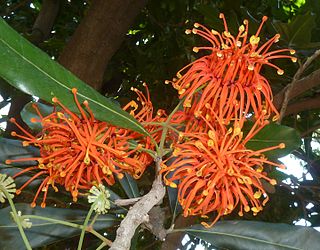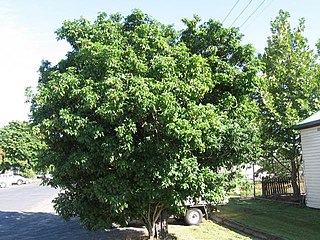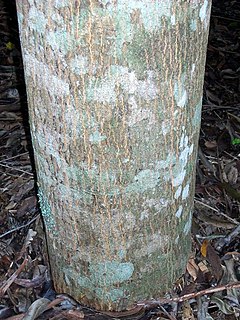| Rhodamnia maideniana | |
|---|---|
 | |
| coppice leaves of Rhodamnia maideniana | |
| Scientific classification | |
| Kingdom: | Plantae |
| Clade: | Angiosperms |
| Clade: | Eudicots |
| Clade: | Rosids |
| Order: | Myrtales |
| Family: | Myrtaceae |
| Genus: | Rhodamnia |
| Species: | R. maideniana |
| Binomial name | |
| Rhodamnia maideniana | |
| Synonyms | |
Rhodamnia maideniana, known as the smooth scrub turpentine, is a rare sub-tropical rainforest plant of eastern Australia. It is listed on ROTAP with a rarity factor of 2RC-. [1]

Rainforests are forests characterized by high rainfall, with annual rainfall in the case of tropical rainforests between 250 and 450 centimetres, and definitions varying by region for temperate rainforests. The monsoon trough, alternatively known as the intertropical convergence zone, plays a significant role in creating the climatic conditions necessary for the Earth's tropical rainforests.

Australia, officially the Commonwealth of Australia, is a sovereign country comprising the mainland of the Australian continent, the island of Tasmania, and numerous smaller islands. It is the largest country in Oceania and the world's sixth-largest country by total area. The neighbouring countries are Papua New Guinea, Indonesia, and East Timor to the north; the Solomon Islands and Vanuatu to the north-east; and New Zealand to the south-east. The population of 25 million is highly urbanised and heavily concentrated on the eastern seaboard. Australia's capital is Canberra, and its largest city is Sydney. The country's other major metropolitan areas are Melbourne, Brisbane, Perth, and Adelaide.
Rare or Threatened Australian Plants, usually abbreviated to ROTAP, is a list of rare or threatened Australian plant taxa. Developed and maintained by the Commonwealth Scientific and Industrial Research Organisation (CSIRO), the most recent edition lists 5031 taxa. The list uses a binary coding system based on the IUCN Red List categories for "Presumed Extinct", "Endangered", "Vulnerable", "Rare" or "Poorly Known". However, it also provides for additional information such as geographic range and occurrence in protected areas.
It occurs in coastal areas, north of the Richmond River, New South Wales and adjacent areas over the border into Queensland. A bushy shrub growing to 3 metres tall. The type specimen was collected by the Richmond River in April, 1891 by W. Bäuerlen.

Queensland is the second-largest and third-most populous state in the Commonwealth of Australia. Situated in the north-east of the country, it is bordered by the Northern Territory, South Australia and New South Wales to the west, south-west and south respectively. To the east, Queensland is bordered by the Coral Sea and Pacific Ocean. To its north is the Torres Strait, with Papua New Guinea located less than 200 km across it from the mainland. The state is the world's sixth-largest sub-national entity, with an area of 1,852,642 square kilometres (715,309 sq mi).

In biology, a type is a particular specimen of an organism to which the scientific name of that organism is formally attached. In other words, a type is an example that serves to anchor or centralize the defining features of that particular taxon. In older usage, a type was a taxon rather than a specimen.
The Generic name Rhodamnia is derived from the Greek Rhodon which means "rose". And aminon, "bowl" where the blood of lambs was poured after sacrifice. It refers to the bowl shaped calyx tubes. [2] The specific epithet is named for the Australian botanist, Joseph Maiden.

Joseph Henry Maiden was a botanist who made a major contribution to knowledge of the Australian flora, especially the Eucalyptus genus. This botanist is denoted by the author abbreviation Maiden when citing a botanical name.
Leaves are typical of this genus, being clearly three veined, 5 to 10 cm long, 2 to 4.5 cm wide. They are hairless, with a prominent drip tip. Oil dots may clearly be seen under a lens. The bark is similarly typical, being rough, fibrous and flaky. Small white flowers appear in late spring or early summer. The fruit is a black berry, around 10 mm in diameter.


















